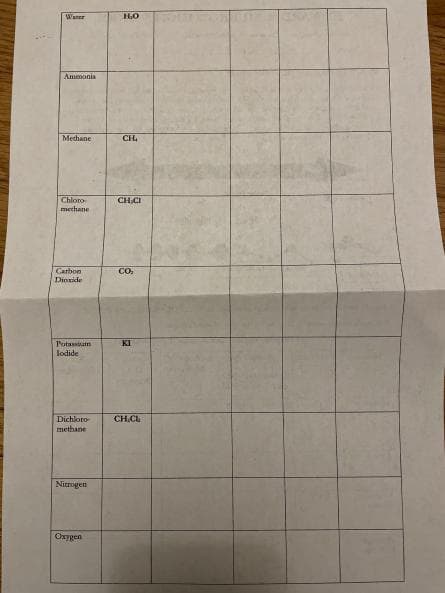Identifying Polar and Non-Polar Bonds: To determine if a compound is Polar or Non- Polar, you must consider the electronegativity difference within cach bond and the 3D shape of the compound. To classify the chemical bond between the atoms calculate the difference in electronegativity between the atoms (Use Table S). If the electronegativity difference is above 1.7 then the bond is Ionic. If the electronegativity difference is below 0.5 then the bond is Nonpolar. Electronegativity differences ranging berween 0.5 and 17 are Polar bonds. Polar Bond Non-Polar lonic Shapes of Molecules Trigonal Pyramidal Tetrahedral Linear Bent INSTRUCTIONS: Classify cach f the bond in the chart as wither: IONIC, POLAR OR NON-POLAR. For each compound: a) Determine the type of bond present b) Draw the electron 'dot' diagtam [Lewis structure] Bond Type Shape of Molecule Name Formula Lewis EN Dot Difference [polar/non-polar covalent or ionic Diagram Hydrogen Nonpolar covalent Jodine Sodium Nitride NaN Hydrogen Chloride HCI Palar Covalent
Types of Chemical Bonds
The attractive force which has the ability of holding various constituent elements like atoms, ions, molecules, etc. together in different chemical species is termed as a chemical bond. Chemical compounds are dependent on the strength of chemical bonds between its constituents. Stronger the chemical bond, more will be the stability in the chemical compounds. Hence, it can be said that bonding defines the stability of chemical compounds.
Polarizability In Organic Chemistry
Polarizability refers to the ability of an atom/molecule to distort the electron cloud of neighboring species towards itself and the process of distortion of electron cloud is known as polarization.
Coordinate Covalent Bonds
A coordinate covalent bond is also known as a dative bond, which is a type of covalent bond. It is formed between two atoms, where the two electrons required to form the bond come from the same atom resulting in a semi-polar bond. The study of coordinate covalent bond or dative bond is important to know about the special type of bonding that leads to different properties. Since covalent compounds are non-polar whereas coordinate bonds results always in polar compounds due to charge separation.
![Identifying Polar and Non-Polar Bonds:
To determine if a compound is Polar or Non- Polar, you must consider the electronegativity
difference within each bond and the 3D shape of the compound. To classify the chemical
bond between the atoms calculate the difference in electronegativity between the atoms (Use
Table S). If the electronegativity difference is above 1.7 then the bond is Ionic. If the
electronegativity difference is below 0.5 then the bond is Nonpolar. Electronegativity
differences ranging between 0.5 and L7 are Polar bonds.
Polar Bond
Non-Polar
lonic
Shapes of Molecules
Trigonal
Pyramidal
Bent
Tetrahedral
Linear
INSTRUCTIONS:
Classify cach f the bond in the chart an wither: IONIC, POLAR OR NON-POLAR.
For each compound: a) Determine the type of bond present
b) Draw the electron 'dot' diagtam [Lewis structure]
Bond Type
Shape of
Molecule
Name
Formula
Lewis
Dot
EN
Difference
[polar/non-polar
covalent or ionic
Diagram
Hydrogen
H.
Nonpolar covalent
Iodine
Sodium
Nitride
NaN
Hydrogen
Chloride
HCI
Palar
Covalent](/v2/_next/image?url=https%3A%2F%2Fcontent.bartleby.com%2Fqna-images%2Fquestion%2Fca759f72-09ba-4af1-b5fe-85c62e93ff5f%2F406a52ad-5ee5-497f-8ca9-d2a3f4fff58c%2Fho5es04_processed.jpeg&w=3840&q=75)

Trending now
This is a popular solution!
Step by step
Solved in 2 steps with 2 images









